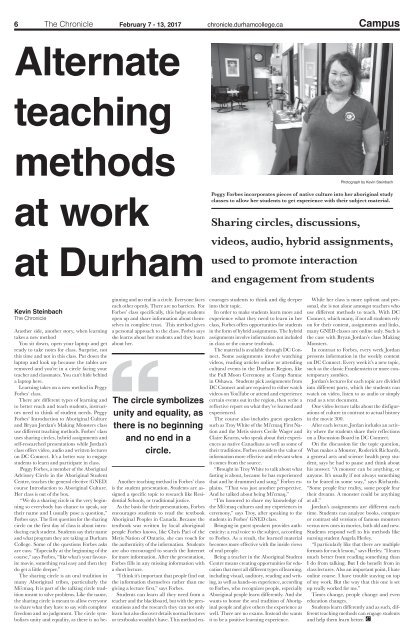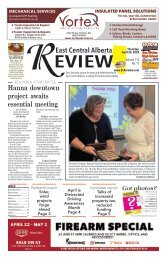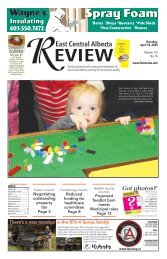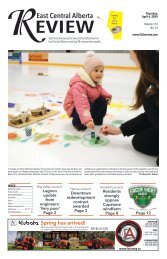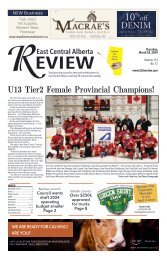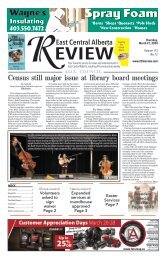You also want an ePaper? Increase the reach of your titles
YUMPU automatically turns print PDFs into web optimized ePapers that Google loves.
6 The Chronicle February 7 - 13, 20<strong>17</strong> chronicle.durhamcollege.ca Campus<br />
Alternate<br />
teaching<br />
methods<br />
Photograph by Kevin Steinbach<br />
at work<br />
at Durham<br />
Peggy Forbes incorporates pieces of native culture into her aboriginal study<br />
classes to allow her students to get experience with their subject material.<br />
Sharing circles, discussions,<br />
videos, audio, hybrid assignments,<br />
used to promote interaction<br />
and engagement from students<br />
Kevin Steinbach<br />
The Chronicle<br />
Another side, another story, when learning<br />
takes a new method<br />
You sit down, open your laptop and get<br />
ready to take notes for class. Surprise, not<br />
this time and not in this class. Put down the<br />
laptop and look up because the tables are<br />
removed and you’re in a circle facing your<br />
teacher and classmates. You can’t hide behind<br />
a laptop here.<br />
Learning takes on a new method in Peggy<br />
Forbes’ class.<br />
There are different types of learning and<br />
to better reach and teach students, instructors<br />
need to think of student needs. Peggy<br />
Forbes’ Introduction to Aboriginal Culture<br />
and Bryan Jordan’s Making Monsters class<br />
use different teaching methods. Forbes’ class<br />
uses sharing circles, hybrid assignments and<br />
self-researched presentations while Jordan’s<br />
class offers video, audio and written lectures<br />
on DC Connect. It’s a better way to engage<br />
students to learn and participate in class.<br />
Peggy Forbes, a member of the Aboriginal<br />
Advisory Circle in the Aboriginal Student<br />
Centre, teaches the general elective (GNED)<br />
course Introduction to Aboriginal Culture.<br />
Her class is out of the box.<br />
“We do a sharing circle in the very beginning<br />
so everybody has chance to speak, say<br />
their name and I usually pose a question,”<br />
Forbes says. The first question for the sharing<br />
circle on the first day of class is about introducing<br />
each student. Students say their name<br />
and what program they are taking at Durham<br />
College. Some of the questions Forbes asks<br />
are easy. “Especially at the beginning of the<br />
course,” says Forbes, “like what’s your favourite<br />
movie, something real easy and then they<br />
do get a little deeper.”<br />
The sharing circle is an oral tradition in<br />
many Aboriginal tribes, particularly the<br />
Mi’cmaq. It is part of the talking circle tradition<br />
meant to solve problems. Like the name,<br />
the sharing circle is meant to allow everyone<br />
to share what they have to say with complete<br />
freedom and no judgement. The circle symbolizes<br />
unity and equality, as there is no beginning<br />
and no end in a circle. Everyone faces<br />
each other openly. There are no barriers. For<br />
Forbes’ class specifically, this helps students<br />
open up and share information about themselves<br />
in complete trust. This method gives<br />
a personal approach to the class. Forbes says<br />
she learns about her students and they learn<br />
about her.<br />
The circle symbolizes<br />
unity and equality, as<br />
there is no beginning<br />
and no end in a<br />
circle.<br />
Another teaching method in Forbes’ class<br />
is the student presentation. Students are assigned<br />
a specific topic to research like Residential<br />
Schools, or traditional justice.<br />
As the basis for their presentations, Forbes<br />
encourages students to read the textbook<br />
Aboriginal Peoples in Canada. Because the<br />
textbook was written by local aboriginal<br />
people Forbes knows, like Chris Paci of the<br />
Metis Nation of Ontario, she can vouch for<br />
the authenticity of the information. Students<br />
are also encouraged to search the Internet<br />
for more information. After the presentation,<br />
Forbes fills in any missing information with<br />
a short lecture.<br />
“I think it’s important that people find out<br />
the information themselves rather than me<br />
giving a lecture first,” says Forbes.<br />
Students can learn all they need from a<br />
teacher and the blackboard, but with the presentations<br />
and the research they can not only<br />
learn but also discover details normal lectures<br />
or textbooks wouldn’t have. This method encourages<br />
students to think and dig deeper<br />
into their topic.<br />
In order to make students learn more and<br />
experience what they need to learn in her<br />
class, Forbes offers opportunities for students<br />
in the form of hybrid assignments. The hybrid<br />
assignments involve information not included<br />
in class or the course textbook.<br />
The material is available through DC Connect.<br />
Some assignments involve watching<br />
videos, reading articles online or attending<br />
cultural events in the Durham Region, like<br />
the Full Moon Ceremony at Camp Samac<br />
in Oshawa. Students pick assignments from<br />
DC Connect and are required to either watch<br />
videos on YouTube or attend and experience<br />
certain events out in the region, then write a<br />
reflective report on what they’ve learned and<br />
experienced.<br />
The course also includes guest speakers<br />
such as Troy White of the Mi’cmaq First Nation<br />
and the Metis sisters Cecile Wager and<br />
Claire Kearns, who speak about their experiences<br />
as native Canadians as well as some of<br />
their traditions. Forbes considers the value of<br />
information more effective and relevant when<br />
it comes from the source.<br />
“Brought in Troy White to talk about what<br />
fasting is about, because he has experienced<br />
that and he drummed and sang,” Forbes explains.<br />
“That was just another perspective.<br />
And he talked about being Mi’cmaq.”<br />
“I’m honored to share my knowledge of<br />
the Mi’cmaq cultures and my experiences in<br />
ceremony,” says Troy, after speaking to the<br />
students in Forbes’ GNED class.<br />
Bringing in guest speakers provides authenticity:<br />
a real voice to the subject, according<br />
to Forbes. As a result, the learned material<br />
becomes more effective with the inside views<br />
of real people.<br />
Being a teacher in the Aboriginal Student<br />
Centre means creating opportunities for education<br />
that meet all different types of learning,<br />
including visual, auditory, reading and writing,<br />
as well as hands-on experience, according<br />
to Forbes, who recognizes people, especially<br />
Aboriginal people learn differently. And she<br />
wants to honor the oral tradition of Aboriginal<br />
people and give others the experience as<br />
well. There are no exams. Instead she wants<br />
it to be a positive learning experience.<br />
While her class is more upfront and personal,<br />
she is not alone amongst teachers who<br />
use different methods to teach. With DC<br />
Connect, which many, if not all students rely<br />
on for their content, assignments and links,<br />
many GNED classes are online only. Such is<br />
the case with Bryan Jordan’s class Making<br />
Monsters.<br />
In contrast to Forbes, every week Jordan<br />
presents information in the weekly content<br />
on DC Connect. Every week it’s a new topic,<br />
such as the classic Frankenstein or more contemporary<br />
zombies.<br />
Jordan’s lectures for each topic are divided<br />
into different parts, which the students can<br />
watch on video, listen to as audio or simply<br />
read as a text document.<br />
One video lecture talks about the disfigurations<br />
of culture in contrast to actual history<br />
in the movie 300.<br />
After each lecture, Jordan includes an activity<br />
where the students share their reflections<br />
on a Discussion Board in DC Connect.<br />
On the discussion for the topic question,<br />
What makes a Monster, Roderick Richards,<br />
a general arts and science health prep student,<br />
says he had to pause and think about<br />
his answer. “A monster can be anything, or<br />
anyone. It’s usually if not always something<br />
to be feared in some way,” says Richards.<br />
“Some people fear reality, some people fear<br />
their dreams. A monster could be anything<br />
at all.”<br />
Jordan’s assignments are different each<br />
time. Students can analyze books, compare<br />
or contrast old versions of famous monsters<br />
versus new ones in movies, both old and new.<br />
Students respond well to his methods like<br />
nursing student Angela Herley.<br />
“I particularly like that there are multiple<br />
formats for each lesson,” says Herley. “I learn<br />
much better from reading something than<br />
I do from talking. But I do benefit from in<br />
class lectures. Also an important point, I hate<br />
online course. I have trouble staying on top<br />
of my work. But the way that this one is set<br />
up really worked for me.”<br />
Times change, people change and even<br />
education changes.<br />
Students learn differently and as such, different<br />
teaching methods can engage students<br />
and help them learn better.


